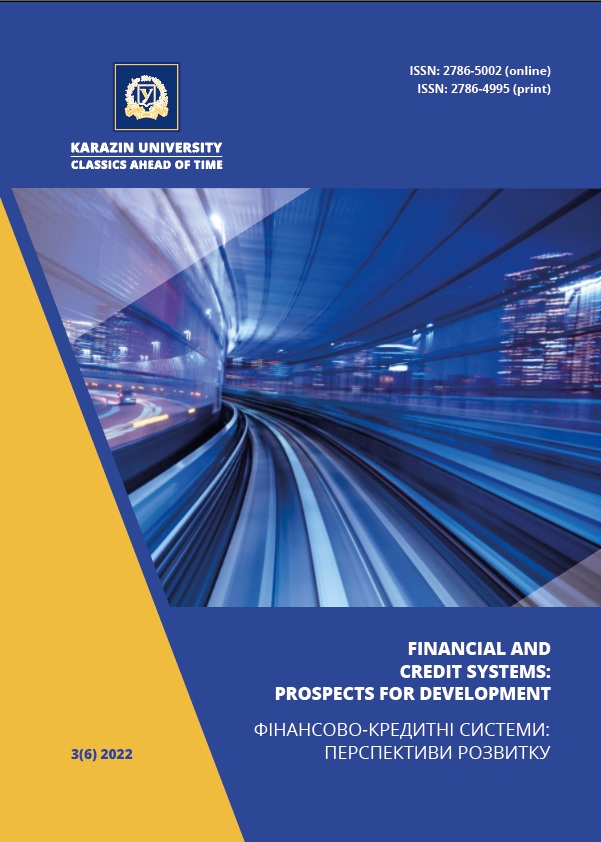FORECASTING AND ANALYSIS OF CRISIS SITUATIONS AT THE ENTERPRISE
Abstract
Enterprises, like individuals, and the state as a whole form monetary funds. Business cash is the part of your cash that is earmarked for a specific purpose. Monetary funds include the statutory fund, employee compensation fund, reserve fund, depreciation fund, etc. Enterprises form cash funds for financial support of operational, financial and investment activities, fulfillment of obligations to the state and contractors, etc. The correct organization of the process of formation of cash funds makes it possible to effectively manage the cash flows of enterprises, make optimal financial decisions, and increase the profitability of economic activity.
A necessary condition for this is the analysis of financial information contained in accounting and statistical reporting in business contracts, settlement, payment and other documents. For the most part, one of the leading subsystems of the financial system of the state, the finances of business structures have their own specifics of organization and performance of their inherent functions. A mandatory element of Ukraine's transition to market relations is the formation of new business structures and the privatization of enterprises.
The history of crises in general shows us that the study of crisis management cannot be tied to a specific civilization or era, especially when humanity has witnessed numerous and complex environmental, political, economic and military crises. In addition, some problems and complex questions of our time have their roots in history. Thus, many geopolitical crises today are the result of old causes.
The article examines both the definition of the essential and substantive characteristics of the concept of crisis management, as well as the model of crisis management at the enterprise and the diagnosis of the probability of bankruptcy, solving the problems of the enterprise's development in the conditions of the transition to the market.
Downloads
References
Gaidis N. M. (2015). Pidvyshchennia efektyvnosti vykorystannia kapitalu pidpryiemstva [Increasing the efficiency of the use of the enterprise's capital]. Visnyk Universytetu bankivskoi spravy, 2. 114-118. Retrieved from: http://nbuv.gov.ua/UJRN/VUbsNbU_2015_2_21 [in Ukrainian].
Golovko O. G., Ponomarenko V. O. (2014). Osoblyvosti stratehichnoho upravlinnia finansovoiu diialnistiu pidpryiemstva [Peculiarities of strategic management of financial activities of the enterprise]. Visnyk Universytetu bankivskoi spravy Natsionalnoho banku Ukrainy, 1 (19). 73-77 [in Ukrainian].
Zaivoronok A. V. (2017). Upravlinnia debitorskoiu zaborhovanistiu [Accounts receivable management]. Molodyi vchenyi, 6. 419-422. Retrieved from: http://nbuv.gov.ua/UJRN/molv_2017_6_97 [in Ukrainian].
Law of Ukraine On Peculiarities of Formation of a Public Joint-Stock Company of Public Railway Transport from February 23, 2012, №. 49, Vidomosti Verkhovnoi Rady Ukrainy. Retrieved from: https://zakon.rada.gov.ua/laws/show/4442-17#Text [in Ukrainian].
Zarubizhni modeli prohnozuvannia bankrutstva pidpryiemstv [Foreign models of forecasting bankruptcy of enterprises]. Retrieved from: http://stud.com.ua/44327/menedzhment/zarubizhni_modeli_prognozuvannya_bankrutstva_pidpriyemstv [in Ukrainian].
Kalichak I. I. (2017). Dyskryminantnyi analiz i yoho zastosuvannia v prohnozuvanni bankrutstva pidpryiemstva [Discriminant analysis and its application in the prediction of bankruptcy of enterprises]. Molodyi vchenyi, 2. 333–339. Retrieved from: http://financial.lnu.edu.ua/wp-content/uploads/2015/10/78.pdf [in Ukrainian].
Wallet V. M. (2020). Napriamy zmitsnennia finansovoho stanu ahrarnykh pidpryiemstv u postkryzovyi period yikh rozvytku [Directions for strengthening the financial condition of agricultural enterprises in the post-crisis period of their development]. Finansovyi prostir, 3. 8-15 [in Ukrainian].
Ligonenko L. O. (2018). Antykryzove upravlinnia pidpryiemstvom. teoretyko-metodolohichni zasady ta praktychnyi instrumentarii [Anti-crisis management of the enterprise. theoretical and methodological principles and practical tools]. [in Ukrainian].
Matviychuk A. V. (2018). Neiromerezhevi ta dyskryminantni modeli diahnostuvannia mozhlyvosti bankrutstva pidpryiemstv [Neural network and discriminant models for diagnosing the possibility of bankruptcy of enterprises]. Visnyk Khmelnytskoho natsionalnoho universytetu. Ekonomichni nauky, 1. 28-29 [in Ukrainian].
Matviychuk A. V. (2018). Analiz ta prohnozuvannia rozvytku finansovo-ekonomichnykh system iz vykorystanniam nechitkoi lohiky [Analysis and forecasting of the development of financial and economic systems using fuzzy logic]. [in Ukrainian].
Melnyk L. H. (2019). Ekolohichna ekonomika. Derzhava ta rehiony [Ecological economy. State and regions]. Ekonomika ta pidpryiemnytstvo,1. 225-254 [in Ukrainian].
Aktsionerne tovarystvo «Ukrainska zaliznytsia» (2022). Ofitsiinyi veb-sait AT «Ukrainska zaliznytsia» [Official website of Ukrzaliznytsia]. Retrieved from: https://www.uz.gov.ua/about/ [in Ukrainian].
Pokaznyky balansu pidpryiemstv za vydamy ekonomichnoi diialnosti [Indicators of the balance sheet of enterprises by types of economic activity]. (2022). Derzhavna sluzhba statystyky Ukrainy [State Statistics Service of Ukraine]. Retrieved from: http://www.ukrstat.gov.ua/ [in Ukrainian].
Prykhodko N. P. (2019). Cutnist antykryzovoho menedzhmentu na pidpryiemstvi [The effectiveness of anti-crisis management at the enterprise]. Investytsii: praktyka ta dosvid, 6. 12-14 [in Ukrainian].
Sapa N.V. (2019). Teoretyko-metodolohichni zasady mekhanizmu antykryzovoho derzhavnoho upravlinnia [Theoretical and methodological foundations of the mechanism of anti-crisis public administration]. Humanitarnyi visnyk ZDIA, 106- 116 [in Ukrainian].
Skibitsky O. M. (2018). Antykryzysnyi menedzhment [Anti-crisis management]. Economics of construction and urban economy, 3. 226-262 [in Ukrainian].
Fink S. K. (2018). Crisis management, planning for the inevitable. Lincoln, Neb. Iuniverse [in English].
Luecke K. L. & Barton I. K. (2019). Crisis management: master the skills to prevent disasters. Boston, Mass. Harvard Business School Press [in English].
Mitroff I.P. (2018). Crisis leadership, planning for the unthinkable. Hoboken, N.J. John Wiley & Sons [in English].
Pearson M. H, Misra S, Clair J. A. & Mitroff I. (2018). Managing the unthinkable. Organizational dynamics, 51-64 [in English].

